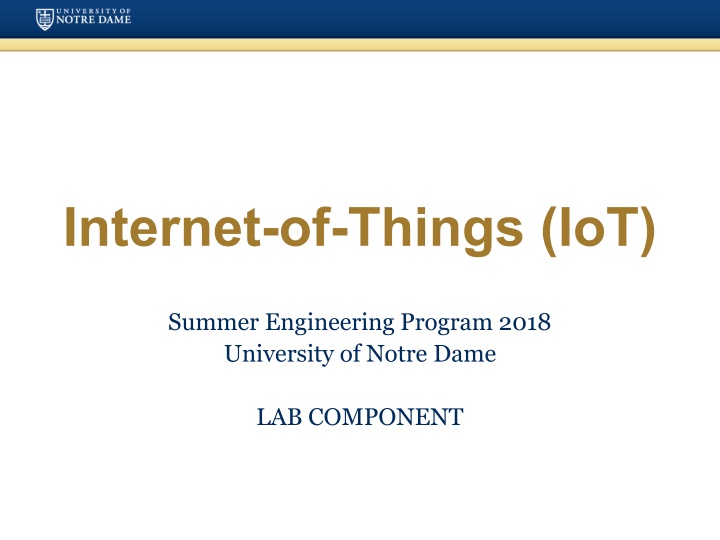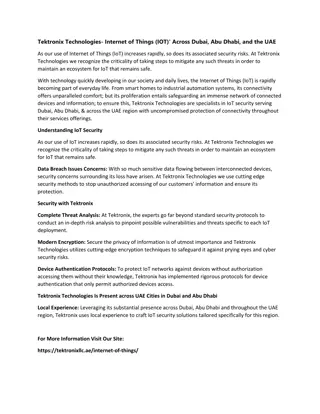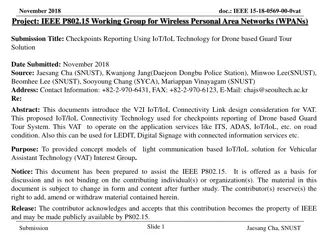
Intruder Detection System Using Bluetooth in IoT Engineering Program
"Learn how to configure Bluetooth and develop a client-server based intruder detection system using Raspberry Pis, PIR sensor, and LED. Submit your report and demo video for evaluation by Friday. Get ready with Bluetooth preparation steps and templates for server and client programs."
Uploaded on | 1 Views
Download Presentation

Please find below an Image/Link to download the presentation.
The content on the website is provided AS IS for your information and personal use only. It may not be sold, licensed, or shared on other websites without obtaining consent from the author. If you encounter any issues during the download, it is possible that the publisher has removed the file from their server.
You are allowed to download the files provided on this website for personal or commercial use, subject to the condition that they are used lawfully. All files are the property of their respective owners.
The content on the website is provided AS IS for your information and personal use only. It may not be sold, licensed, or shared on other websites without obtaining consent from the author.
E N D
Presentation Transcript
Internet-of-Things (IoT) Summer Engineering Program 2018 University of Notre Dame LAB COMPONENT
Assignment 3 Task 1: Configure Bluetooth Task 2: Write a client-server based intruder detection system using 2 Pis, a PIR sensor, and an LED (and/or sounder) One Pi acts as server and uses a callback function that triggers when motion is detected The other Pi acts as client and queries the server for the PIR value once every 5 seconds; if an intrusion is detected, the alarm is raised Test both your client AND server program with the help of one (or more) of your classmates (or the TA if needed)
Assignment 3 Deliverables By Friday midnight submit a report showing clearly your client and server programs Indicate your Bluetooth address Indicate if you ran into any problems during development or if any parts are incomplete/etc. Provide a brief video (no longer than 30 seconds each) that shows your Pi and your classmate s Pi work together as intrusion detection system Summary: there are two documents for this assignment: one PDF report (with code) and one video
Bluetooth Preparation Make sure Internet sharing is w0rking (e.g., ping a remote IP address) Install the Bluez Bluetooth module on your Pi: sudo apt-get update sudo apt-get install python-bluez Configure Bluetooth: sudo bluetoothctl type: agent on type: default-agent type: scan on type: quit Activate scanning: sudo hciconfig hci0 piscan This call needs to be done after each reboot of the Pi! If needed, you can find your Pi s BT address using the following command: hciconfig (the address format is: XX:XX:XX:XX:XX:XX)
Bluetooth Server Template import bluetooth hostMACAddress = '' port = 3 backlog = 1 size = 1024 s = bluetooth.BluetoothSocket(bluetooth.RFCOMM) s.bind((hostMACAddress, port)) s.listen(backlog) try: client, clientInfo = s.accept() while 1: data = client.recv(size) if data: print(data) client.send("Returning: " + data) except: client.close() s.close()
Bluetooth Client Template import bluetooth serverMACAddress = XX:XX:XX:XX:XX:XX' port = 3 size = 1024 s = bluetooth.BluetoothSocket(bluetooth.RFCOMM) s.connect((serverMACAddress, port)) while 1: text = raw_input("Text to send: ") if text == "quit": break s.send(text) data = s.recv(size) print(data) s.close()
Notes The client specifies the address of the server The server specifies an empty address (the server will find its BT adapter address by itself) The port number can be changed, but must be the same in both client & server The size value indicates the maximum size of a data transfer






















